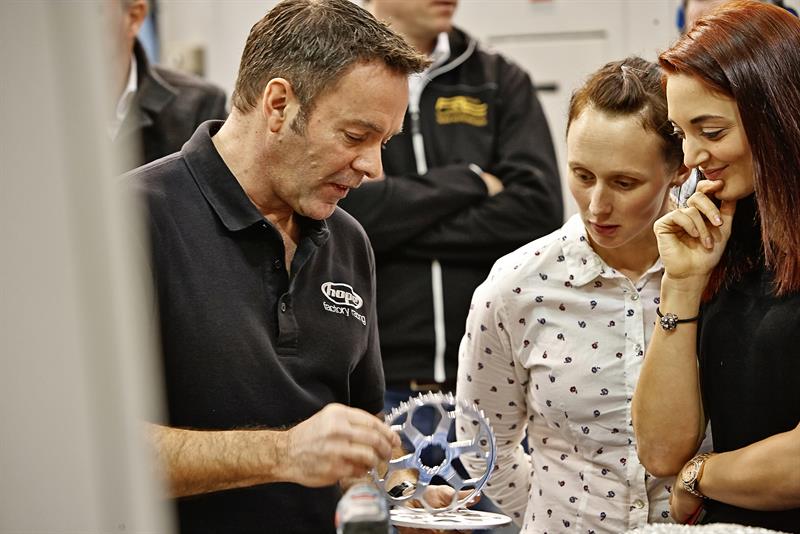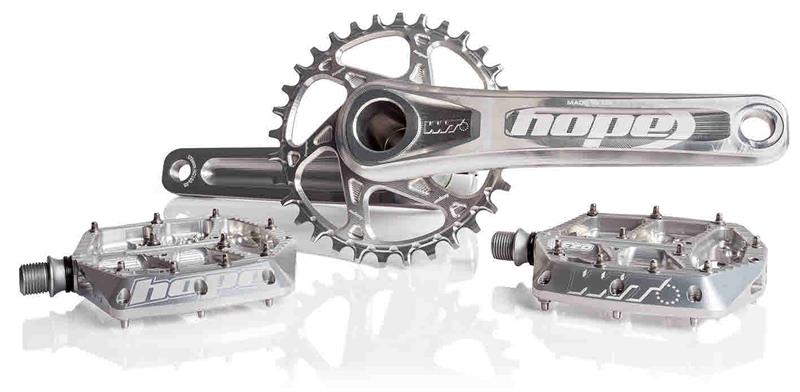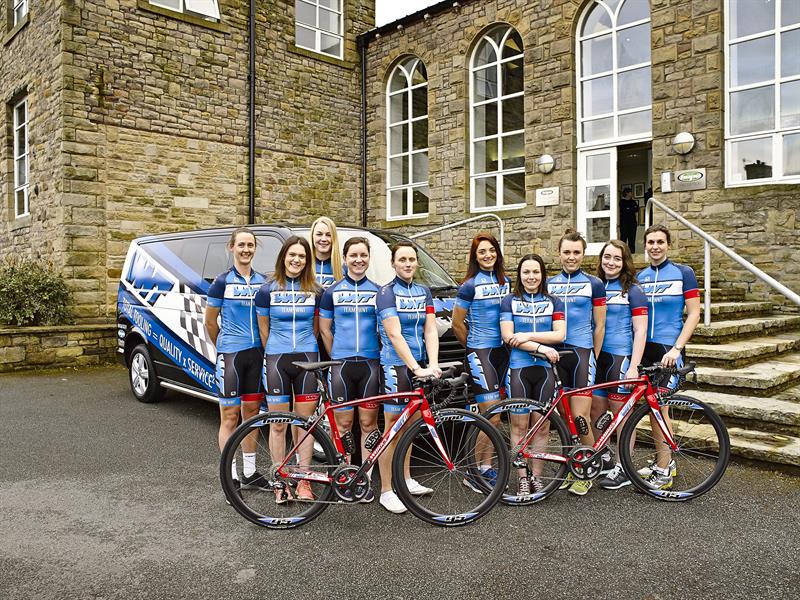For cycling enthusiasts, particularly mountain bikers/off-roaders, Hope Technology will be a familiar brand. To others, it may not register; especially as the company is not a bike manufacturer, but rather a maker of high-tech bike components. It designs, manufactures and supplies through distributors a variety of componentry to the aftermarket – disc brakes, hubs, cranks, handlebar stems, pedals, gear sprockets, lights and more. Specialist bike makers are also served.
Targeting a lifestyle/enthusiast/professional cycling market, the 116-employee company is the UK's largest manufacturer of bicycle components. Most products are machined from aluminium and anodised in one of six colours, but carbon fibre parts, such as seat posts, handlebars and more, are under development.
Today, the company has some 6,000 line items, excluding colour variation, with some 100,000 parts passing through the Barnoldswick, Lancashire-based company's anodising department per week. Through their supply, Hope Technology draws its income about 50-50 from the UK and overseas, taking in some 40 countries. This home-grown globally successful high-tech bicycle parts design and manufacturing operation has even caught the attention of Prime Minister David Cameron, who visited the company in April 2013.
ROOTS OF SUCCESS
Underlying the bike part specialist's success is its unusual approach to various matters of design, manufacturing and employee reward. And the essence of the company very much rests on the founders' work experience and leisure time pursuits.
Directors Ian Weatherill and Simon Sharp are both ex-Rolls-Royce apprentices – Barnoldswick is Rolls-Royce aero engine territory, of course. Both were, and remain, motorbike trials riders and both keep fit for this by riding mountain bikes.
The pair set up a toolmaking business, Instant Precision Company (IPCO), in the mid-1980s and initially undertook work for Rolls-Royce and others. IPCO's move into bicycle parts came later in the same decade when the founders decided to manufacture for their mountain bikes disc brakes similar to those employed on their trials motorbikes. Exhibition attendance at Interbike in America in 1992 brought Hope Technology wider recognition. That name for its bike parts operation had been born the previous year, it being taken from the mill (Hope Mill) to which the company had moved a year before, and where it has since expanded to today's 90,000 ft2 operation.
With an aerospace quality mentality, the manufacturing know-how and attention-to-detail and problem-solving approach gained via a toolmaking background, plus their enthusiasm for two-wheeled pursuits, Weatherill and Sharp look at the world somewhat differently to other manufacturing company directors. One of the key expressions of this is that Hope Technology makes almost everything in-house, even anodising parts on site. This is in complete opposition to today's approach of specialisation on core competences and subcontracting elsewhere.
On the day of the Team WNT Elite Women's Cycle Team launch at Barnoldswick in late February, the assembled press bumped into Weatherill and he offered an explanation. "We don't have a financial director," was one of his first revelations. Basically, the existence of such a position and associated systems would result in parts manufacture subcontracted, probably overseas, on the basis of an uneconomic in-house hourly charge rate. "The hourly rate would be so high that you wouldn't be able to compete. But we say, if someone else is making it, we can make it, and buy the machines to do so. We don't think about the cost of the machine. It's the market that dictates the price at which you can sell a part. We make things as efficiently as possible. We buy the best machine; the best kit. At the end of the day, it works, we are profitable."
MAKING IT EFFICIENTLY
Hope Technology runs its high-tech production equipment round the clock, seven days a week, while the roll-call of machinery takes in multiple pallet-loaded Matsuura horizontal machining centres (01530 511400), several bar-fed Citizen and Miyano CNC lathes (01923 691500), gantry-fed Nakamura Tome (ETG, 01926 818418) and Takamaz lathes (Warwick Machinery, 01926 497806), a Bystronic laser profiler (0844 848 5850) and a robot-loaded heat treatment process, for example. The company has some 55 CNC machines in total, programmed with GibbsCAM (Tech CADCAM, 01284 75478 ) and, increasingly, Delcam (0121 766 5544) software. WNT (UK) is its tooling partner (0800 073 2073), supporting the company in its efforts to manufacture as cost-effectively as possible (see 'Partner in effective cutting', below).
This idiosyncratic view of manufacturing finances is evident elsewhere. Carbon fibre parts? Well, the industry charges over the odds [a] for subcontract parts manufacture and [b] for mould tooling to support their manufacture, so do it all in house. Explains Weatherill, the charge-out rates for carbon fibre parts are unjustifiably high at around £150/hour because, essentially, the aerospace and F1 industry are willing to bear those costs. In reality, the cost to lay up carbon fibre parts is a £12 labour rate and the material cost. As for mould tools, well, Weatherill and Sharp are toolmakers, so no problem there. "They might be £30,000 to buy in; for us it's just £1,000+," he adds. A 1,200 ft2 unit is being built to support R&D of carbon fibre parts, incidentally.
This can-do thinking allied to an understanding as to why costs may be inflated carries over to just about everything, it seems. Can't get time in a velodrome? Build one yourself. Yes, plans are underway for just that, with another R&D centre underneath, on a six acre site, at a fraction of the cost of what, let's say, the UK stumped up for the Olympic velodrome. Weatherill waxes lyrical about cost build-up on that particular project.

Lindley Pate (left), Hope Technology's works and production manager, shows WNT women's cycling team's
Jo Tindley (centre) and Charlene Joiner (right) some of the company's kit, on which they will be relying
But this 'do it in-house focus' is only part of the story. The efforts of its workforce are brought to bear to leverage that. Everyone in the factory is thinking about "how to make it faster, better; or about new products", the director offers.
Within the factory, this is easily understood, but what about the product design and refinement side? Well, every one of its staff gets a 'Hope Technology' bike – "We run a fleet of 250 at about £1 million at retail value," says Alan Weatherill, Ian's brother, who heads up sales and marketing. This allows employees to ride, test and comment on existing designs, contributing to design and/or manufacturing improvements, or prompting ideas for new kit – the company's purpose-built track behind the factory supports their efforts. (It goes without saying that everybody at the factory has a cycling interest, of course – there's a waiting list of potential employees, too.) And on the investment required to turn any subsequent ideas into reality, Ian Weatherill offers: "Even if we don't make a profit [out of an idea] this year, we will next."
Apart from pure cycling interest, motivating the staff is the fact that they are rewarded in direct relationship to turnover growth; a 1% growth and they get a 1% pay rise. When it gets to 5%, they get a 3% pay rise and 2% as a lump sum, paid in May.
"We grew by 8% in 2013 and by 13% last year, so there's a quarter of a million pounds to be paid out this year," Ian Weatherill says, in underlining what this actually means in hard cash terms. But that's turnover, what about profit? "It's up to me to make a profit out of turnover," the director shrugs – and the company clearly does.
So, all this is what underpins those high quality, long-lasting, innovative Hope Technology products for which the company is known – oh, and it has its own materials test house to make sure that products perform in line with that brand image – "We always exceed the relevant standards," Alan Weatherill underlines.
But, as regards Hope Technology's novel approach to profitable large-scale in-house manufacturing, maybe the company offers a broader, more intriguing example to manufacturers more generally.
Partner in effective cutting

Some of the aluminium parts that Hope Technology manufactures at its Barnoldswick location on high-tech machinery running round the lock, using tools from WNT (UK)
Hope Technology has a long-standing relationship with WNT (UK) (0800 073 2073) for the supply of cutting tools. "We have worked with WNT for many years, in part due to a common interest in cycling among each company's employees, but also because of the quality and service that we get from them," says Lindley Pate, Hope Technology's works and production manager. "Every time we look at a new tool from WNT, we gain, in terms of productivity, over any other tool that we may have been using and, as a result, we now tend to view WNT as the first option when it comes to cutting tools, as its range covers more applications, and the service, delivery and support is excellent. To be able to get cutting tools delivered from Germany the next morning is just what we need, as you never know when you will need something urgently."
An example of this tooling partnership is a Nakamura Tome WY-100 twin-spindle, gantry-loaded, turning centre machining a range of forged aluminium wheel hubs. Previously made on another machine using a 'mish-mash' of tools from various suppliers, responsibility for tooling was given to WNT (UK) completely. All tools used on this project have polished and ground geometries to enhance the surface finish on the aluminium components, which then go on to machine-based polishing prior to anodising.
Apart from a significant improvement in performance, in terms of tool life and quality, the security of cutting edges gives Pate the confidence to run lights-out and unmanned on this machine, and he adds: "This was an important project for Hope Technology as hubs are high volume production for us, so consistent manufacture is vital. Quality is also a major issue. We are machining bearing diameters to microns, as the parts are designed for servicing by customers, who therefore need interchangeability of parts; they don't want trial and error while repairing a bike out in the field. The success of the WNT tools on this project gives us further impetus to continue the gradual switch to 100% WNT tooling in the future on all of our machines."
New cycling team wheeled out

The team, L to R: Rose Osborne, Becca Carter, Brit Tate, Lydia Boylan, Jo Tindley, Charlene Joiner, Sam Burman, Hannah Walker, Sophie Lankford, Victoria Williams
Team WNT Elite Women's Cycle Team will ride bikes featuring Hope Technology componentry that has been specially etched with WNT's logo.
Explains WNT (UK) managing director Tony Pennington: "We dipped our toe into cycle sponsorship last year by supporting Sam Burman – who we also sponsor in motorcycle racing – and a small team, in order to gain a better understanding of women's cycling. Having witnessed the excitement and passion involved, it was a logical step to increase our participation, with the help of Sam and team manager Marcus Nainby.
"With the launch of Team WNT, we are excited at the prospect of fielding such a strong team in our first full season in the Women's Elite Series. We see our sponsorship, and the partnerships we have developed with companies such as Hope Technology, as a fantastic marketing tool to create exposure for our business and also to provide opportunities for our customers to become involved, while providing a boost for women's cycling in the UK. We are very ambitious and committed to this project and who knows where it will lead in years to come."










